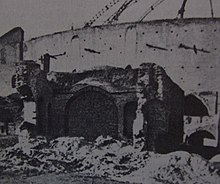Síyáh-Chál

Síyáh-Chál (Persian: سیاه چال literally "black pit") is the common word in Persian language for "dungeon".
Historically, siyah-chals were used as a harsher form of incarceration. Typically, such dungeons had no windows or outlets, other than the entrance, consisting of a short stairway into the ground.
In Bahá'í history the "Síyáh-Chál" refers to the dungeon south east of the palace of the Sháh and near the Sabzih-Maydán in Tehran where Bahá'u'lláh, founder of the Bahá'í Faith, was in captivity in 1852,[1] together with about 30 other Bábí's.[2] He claimed that here he had a vision of a Maid of Heaven, through whom he received his mission as a Messenger of God and as the One whose coming the Báb had prophesied.[3] He described his experiences in his Epistle to the Son of the Wolf and Súriy-i-Haykal.[4][5] It was also the place where he composed his first known tablet, the Rashh-i-'Amá.[6]
In 1868 the dungeon was filled-in and the Tikyíh Dowlat, a royal mourning center for Imam Husayn, was built over the site.[7] The site was Bahá'í property from 1954 until the Islamic Revolution of 1979. It has been described by Shoghi Effendi as the second holiest Bahá'í site in Iran.[3]
References
- ^ Momen, Mojan (2009). "Tehran (Tihrán), Iran". Bahá’í Encyclopedia Project. Evanston, IL: National Spiritual Assembly of the Bahá’ís of the United States.
- ^ Bahá'í International Community (1992). Bahá’u’lláh. Bahá'í World Centre. p. 3.
- ^ a b Smith, Peter (2000). "Síyáh-Chál". A concise encyclopedia of the Bahá'í Faith. Oxford: Oneworld Publications. pp. 323–267. ISBN 1-85168-184-1.
- ^ Bahá'u'lláh (1988) [1892]. Epistle to the Son of the Wolf. Wilmette, Illinois, USA: Bahá'í Publishing Trust. pp. 20–22. ISBN 0-87743-182-5.
- ^ Bahá’u’lláh, Summons of the Lord of Hosts, pp. 5
- ^ Cole, Juan. "Baha'u'llah and the Naqshbandi Sufis in Iraq, 1854-1856", from Iran East and West: Studies in Babi and Baha'i History, vol. 2 (edited, with Moojan Momen, and contributor); Los Angeles: Kalimat Press, 1984, pp. 10-12.
- ^ Khadem, Dhikru'llah (1976). "Bahá'u'lláh and His Most Holy Shrine". Bahá'í News (540): 9.
{{cite journal}}: Unknown parameter|month=ignored (help)
